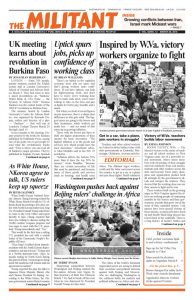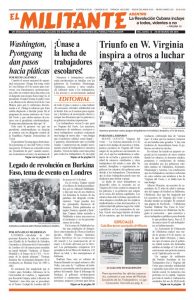There’s an uptick in the capitalist economy, more jobs are open, and that’s giving workers more confidence. If you have options, can look for higher-paying work, and don’t have to worry every working hour how to make ends meet, you’re more willing to take on the boss and join in fights for better pay, benefits and a union.
But when you look at recent figures on pay increases, there’s a sharp class difference in who gets what. The biggest raises are going to the bosses and their henchmen, while workers get much less — and see much of that eaten up in growing inflation.
Those with the lowest pay have to shell out higher proportions of their income for basic necessities. “The highest inflation is in the goods and services over which people have the least discretion,” investment adviser John Mauldin said in his Feb. 25 newsletter.
“Inflation affects the bottom 50% more than it does the top 50% by income,” wrote Mauldin. “Because there are certain necessities of life that must be purchased, and because many of those goods and services (such as housing, and health care) have higher than average inflation, the bottom half suffers a much higher inflation rate than the overall national average.”
According to the government’s Consumer Price Index, overall inflation over the past 20 years totaled 55.6 percent. Median wages barely went above this figure, with housing and food not far behind. Increases for medical care and child care were more than double the inflation figure. Costs for “hospital services” went up close to 250 percent. At the same time, clothes, household furnishings, TVs, cellphones and software technology declined in prices — big-ticket items that workers can set aside to make ends meet.
The government’s “core” Consumer Price Index rate, which excludes items that eat up higher percentages of workers’ wages, like food and gas to drive to work, was up 1.8 percent over the past year. But average weekly wages didn’t keep pace, rising only 0.4 percent, according to the Labor Department.
Many workers are forced to turn to credit cards or “payday” loans to get by, and rapidly find themselves saddled with rising interest payments and debt.
One reflection of workers feeling they can find better paying work was reflected when the Labor Department announced 313,000 jobs were created in February. As workers look for better options, there’s a shortage in some of the lowest paying and most grueling jobs. That includes farmworkers, so crops are rotting in the fields, Fortune magazine reported. Farmers in California and elsewhere are pressing Washington to let in more immigrants, one way or another.
There is a sharp shortage of thousands of long-haul truckers, as higher wages for some is boosting spending and production. But, “it’s a hard life,” driver Greg Gedenberg told CBS News at a truck stop on I-80 in Iowa. “I mean, I’ve got a 36-inch box that I’m sleeping in, in the back of my truck.”
“I think if they want to hire more drivers,” he said, “they’re gonna have to increase the pay.” But fleet owners are resistant, fighting to defend profits amid rising competition.
Pay for U.S. bosses and their henchmen on the shop floor have skyrocketed. From 1978 to 2013, compensation packages for corporate CEOs rose 937 percent. The top bosses at the five largest banks were paid on average $25.3 million last year, up 17 percent from 2016.
‘Wages have hardly budged’
“Even after eight years of economic recovery and steady private-sector job growth, wages for most Americans have hardly budged,” reported the New York Times Feb. 28.
In some areas where one major employer dominates the market, like Walmart in many small towns or coal companies in West Virginia, bosses have pressured workers to sign contracts with “noncompete clauses” that limit workers’ ability to find new jobs after leaving an old one. One in five workers with a high school education or less are saddled with these restrictions.
This situation results from the fact that bosses have taken advantage of the weakening of workers’ unions today. The number of unionized manufacturing workers fell from 15 to less that 10 percent over the last 15 years.
While the number of unionized workers overall has fallen by 2.9 million since 1983, the number of workers grew from 88 million to 133 million, the government says.
The official unemployment rate for February is at a near-record low of 4.1 percent, but this figure excludes workers eliminated from the workforce because they’ve been out of work long-term. The so-called labor force participation rate — those employed or actively looking for work — was 63 percent in February, just a small increase during the capitalist “recovery” and still near its lowest level since the late 1970s. And some 5.2 million people wanting full-time work are employed part time.
Meanwhile, credit card debt has reached a seven-year high. In the fourth quarter of 2017 credit cards accounted for 59 percent of all loans written off by the banks as uncollectable, some $11.9 billion. Overall consumer debt, excluding mortgages and other home loans, rose 5.5 percent from a year earlier to $3.82 trillion, the highest on record.

